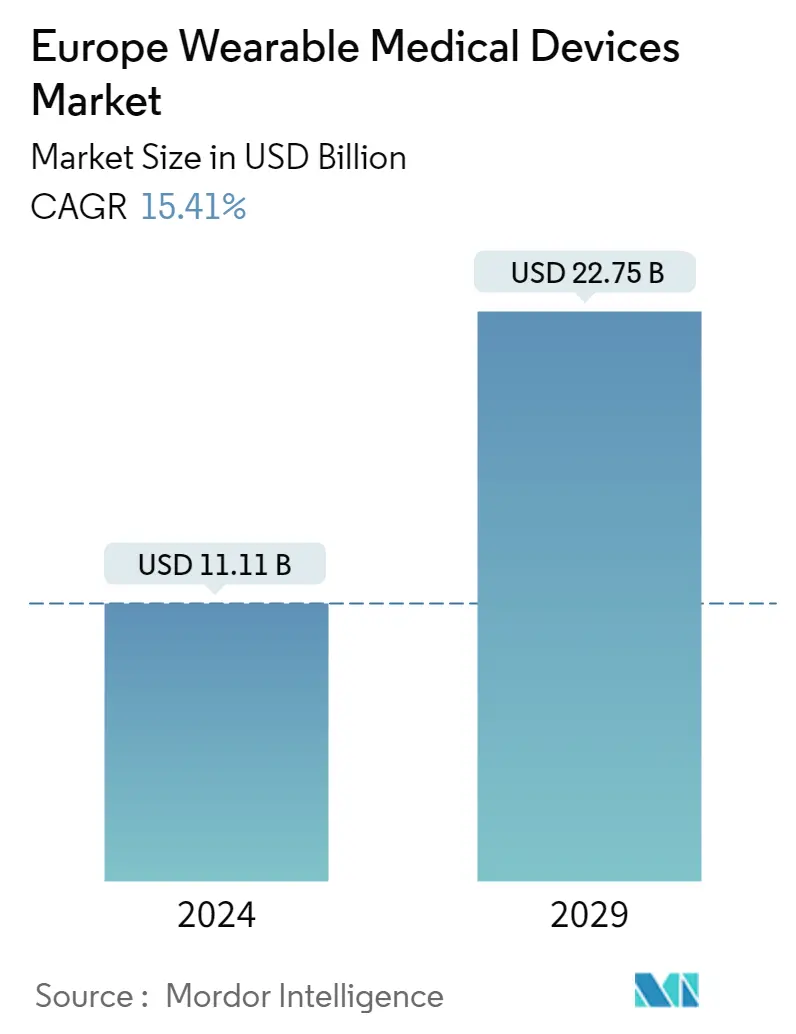Market Size of Europe Wearable Medical Devices Industry

| Study Period | 2019 - 2029 |
| Base Year For Estimation | 2023 |
| Forecast Data Period | 2024 - 2029 |
| Market Size (2024) | USD 11.11 Billion |
| Market Size (2029) | USD 22.75 Billion |
| CAGR (2024 - 2029) | 15.41 % |
Major Players
*Disclaimer: Major Players sorted in no particular order |
Europe Wearable Medical Devices Market Analysis
The Europe Wearable Medical Devices Market size is estimated at USD 11.11 billion in 2024, and is expected to reach USD 22.75 billion by 2029, growing at a CAGR of 15.41% during the forecast period (2024-2029).
The COVID-19 pandemic has significantly impacted market growth. The demand for wearable devices and patient monitoring devices has increased during the pandemic period as they allow contactless communication and tracking of medical conditions by clinicians. The spread and early diagnosis of COVID-19 can be determined through the remote monitoring of vital signs such as skin and body temperature, respiratory rate, pulse rate, heart rate, and blood oxygen level, which are related to COVID-19. This is anticipated to have a positive effect on the growth of the studied market. For instance, according to an article published by The Lancet Digital Health Journal, in April 2022, titled "Effectiveness and safety of pulse oximetry in remote patient monitoring of patients with COVID-19: a systematic review", it has been found that pulse oximetry is a practical method for determining whether patients need hospital treatment or may be safely handled at home by remotely monitoring their SpO2 levels.
In addition, as per the same source, in the United Kingdom, COVID Oximetry @home15 is a national program of care for patients with COVID-19 in England. The program aims to monitor SpO2 remotely in patients who are at the risk of worsening from silent hypoxia. Also, the model seeks to improve patient care and ensure more efficient use of National Health Service resources. Hence, the increased usage of remote patient monitoring devices and other wearable devices to monitor health conditions during pandemics has positively impacted the market growth. Similarly, according to a study published in Nature Electronics, in January 2021, titled "Wearable devices for the detection of COVID-19," the early diagnosis of asymptomatic and presymptomatic COVID-19 cases can be accomplished by using wearable electronic devices that continuously monitor physiological data. Thus, the increasing use of wearable devices in diagnosing and detecting the COVID-19 symptoms and monitoring the health condition of various patients suffering from chronic diseases is expected to increase the adoption of these devices among the population, which in turn is expected to increase the market growth during the COVID-19 pandemic.
Certain factors that are driving the market growth are rising technological advancements and product innovation, increasing health awareness among the population, and advantages offered by the wearable devices such as ease of use and data interpretation.
Other factors, such as continuous product development and commercialization, and strengthening distribution channels of major product manufacturers are expected to aid the growth of the Europe wearable medical devices market. For instance, in December 2021, Xiaomi launched Redmi Watch 2 Lite smartwatch in the European market, Germany for EUR 79. It supports several features, including tracking blood oxygen levels, steps taken, and heart rate. Also, in April 2020, Withings launched the latest sleep-tracking device, Sleep Analyzer, a mat that can be used to detect sleep apnea. The device analyzes sleep and snoring episodes by using its advanced sensors when placed underneath a mattress.
Furthermore, the increasing initiatives to rise health awareness regarding various chronic diseases among the population in the region are also contributing to the growth of the studied market over the forecast period. For instance, in December 2021, the European Commission launched the Healthier Together - EU non-communicable diseases (NCD) initiative to support European countries in identifying and implementing effective policies and actions to reduce the burden of major NCDs and improve citizens' health and well-being. The initiative includes five strands such as health determinants, cardiovascular diseases, diabetes, chronic respiratory diseases, mental health, and neurological disorders.
However, the lack of reimbursement policies in Europe is likely to restrain the market growth over the forecast period.
Europe Wearable Medical Devices Industry Segmentation
As per the scope of the report, wearable medical devices are autonomous devices capable of diagnosing or monitoring medical conditions, combined with digital health information, typically worn over the body. These devices possess features, such as noninvasive physiological sensors, data processing modules, medical feedback, and wireless data transmission capabilities. The Europe Wearable Medical Devices Market is segmented by Device Type (Monitoring Devices and Therapeutic Devices), Application (Sports and Fitness, Remote Patient Monitoring, and Home Healthcare), Product Type (Watch, Wristband, Ear Wear, and Other Product Types), and Geography. The report offers the value (in USD million) for the above segments.
| By Device Type | ||||||
| ||||||
|
| By Application | |
| Sports and Fitness | |
| Remote Patient Monitoring | |
| Home Healthcare |
| By Product Type | |
| Watch | |
| Wristband | |
| Ear Wear | |
| Other Product Types |
| Geography | |
| Germany | |
| United Kingdom | |
| France | |
| Italy | |
| Spain | |
| Rest of Europe |
Europe Wearable Medical Devices Market Size Summary
The Europe wearable medical devices market is poised for significant growth, driven by the increasing demand for remote patient monitoring solutions and the rising prevalence of chronic diseases. The COVID-19 pandemic has accelerated the adoption of these devices, as they facilitate contactless monitoring and early diagnosis of health conditions, including those related to COVID-19. This trend is supported by initiatives such as the UK's COVID Oximetry @home program, which underscores the importance of remote monitoring in managing patient care efficiently. Technological advancements and product innovations, along with heightened health awareness, are further propelling market expansion. The introduction of new products, such as Xiaomi's Redmi Watch 2 Lite and Withings' Sleep Analyzer, highlights the ongoing development and commercialization efforts by key players in the market.
The market's growth is also supported by the increasing geriatric population in Europe, who are more susceptible to chronic conditions, thereby driving the demand for wearable devices that offer ease of use and data interpretation. Initiatives like the European Commission's Healthier Together program aim to reduce the burden of non-communicable diseases, further contributing to market growth. However, the lack of reimbursement policies in Europe poses a challenge to market expansion. Despite this, the remote patient monitoring segment is expected to witness substantial growth due to its ability to provide real-time insights into patients' health, reducing healthcare costs and hospitalizations. Key players such as Abbott Laboratories, Fitbit, and Omron Corporation are actively engaging in strategic collaborations and product launches to strengthen their market presence.
Europe Wearable Medical Devices Market Size - Table of Contents
-
1. MARKET DYNAMICS
-
1.1 Market Overview
-
1.2 Market Drivers
-
1.2.1 Technological Advancements and Innovation
-
1.2.2 Increasing Health Awareness
-
1.2.3 Ease of Use and Interpretation of Data
-
-
1.3 Market Restraints
-
1.3.1 Lack of Reimbursement Policies
-
-
1.4 Porter's Five Force Analysis
-
1.4.1 Threat of New Entrants
-
1.4.2 Bargaining Power of Buyers/Consumers
-
1.4.3 Bargaining Power of Suppliers
-
1.4.4 Threat of Substitute Products
-
1.4.5 Intensity of Competitive Rivalry
-
-
-
2. MARKET SEGMENTATION (Market Size by Value in USD million)
-
2.1 By Device Type
-
2.1.1 Monitoring Devices
-
2.1.1.1 Vital Sign Monitoring Devices
-
2.1.1.2 Sleep Monitoring Devices
-
2.1.1.3 Electrocardiographs, Fetal and Obstetric Devices
-
2.1.1.4 Neuromonitoring Devices
-
-
2.1.2 Therapeutic Devices
-
2.1.2.1 Pain Management Devices
-
2.1.2.2 Rehabilitation Devices
-
2.1.2.3 Respiratory Therapy Devices
-
2.1.2.4 Other Theraputic Devices
-
-
-
2.2 By Application
-
2.2.1 Sports and Fitness
-
2.2.2 Remote Patient Monitoring
-
2.2.3 Home Healthcare
-
-
2.3 By Product Type
-
2.3.1 Watch
-
2.3.2 Wristband
-
2.3.3 Ear Wear
-
2.3.4 Other Product Types
-
-
2.4 Geography
-
2.4.1 Germany
-
2.4.2 United Kingdom
-
2.4.3 France
-
2.4.4 Italy
-
2.4.5 Spain
-
2.4.6 Rest of Europe
-
-
Europe Wearable Medical Devices Market Size FAQs
How big is the Europe Wearable Medical Devices Market?
The Europe Wearable Medical Devices Market size is expected to reach USD 11.11 billion in 2024 and grow at a CAGR of 15.41% to reach USD 22.75 billion by 2029.
What is the current Europe Wearable Medical Devices Market size?
In 2024, the Europe Wearable Medical Devices Market size is expected to reach USD 11.11 billion.

